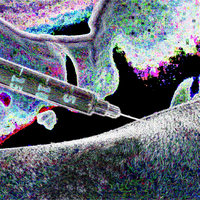| Gly | |
|---|---|
| Esters [] | |
|---|---|
| Glycine acetate | |
| Glycine benzoate | |
| Molecular structure via molpic based on CDK |
| Physical properties [] | |
|---|---|
| Molecular mass | 75.07 g/mol [1] |
| Density | 1.1607 (NTP, 1992) - Denser than water; will sink g/cm3 [1] |
| Appearance | White crystals [1] |
| Odor | Odorless [1] |
| Taste | Sweet [1] |
| Melting point | 451 ° [1] |
| Decomposition | STARTS TO DECOMP AT 233 °C [1] |
| Solubility | greater than or equal to 100 mg/mL at 64 °F (NTP, 1992) [1] |
| Predicted LogP | -3.2 [1] |
| Structural Identifiers [] | |
|---|---|
| Molecular formula | C2H5NO2 [1] |
| IUPAC name | 2-aminoacetic acid [1] |
| SMILES | C(C(=O)O)N [1] |
| InChI | InChI=1S/C2H5NO2/c3-1-2(4)5/h1,3H2,(H,4,5) [1] |
| InChIKey | DHMQDGOQFOQNFH-UHFFFAOYSA-N [1] |
Glycine
Glycine (also known as Glycocoll, Glycolixir, Glicoamin, Glycosthene, Aciport, Padil, Hampshire glycine, Amitone, Leimzucker or Aminoazijnzuur) is a
Chemistry
Salts and Esters []
Glycine is typically found in the form of its hydrochloride and hydriodide salts
or its acetate and benzoate esters.
Stereochemistry []
Glycine is a achiral mixture
 Anodyne
Anodyne